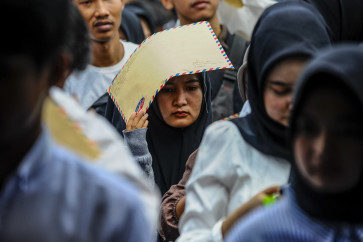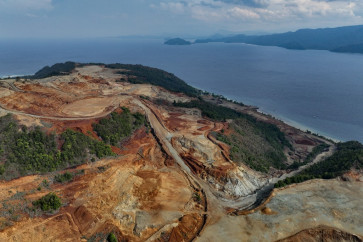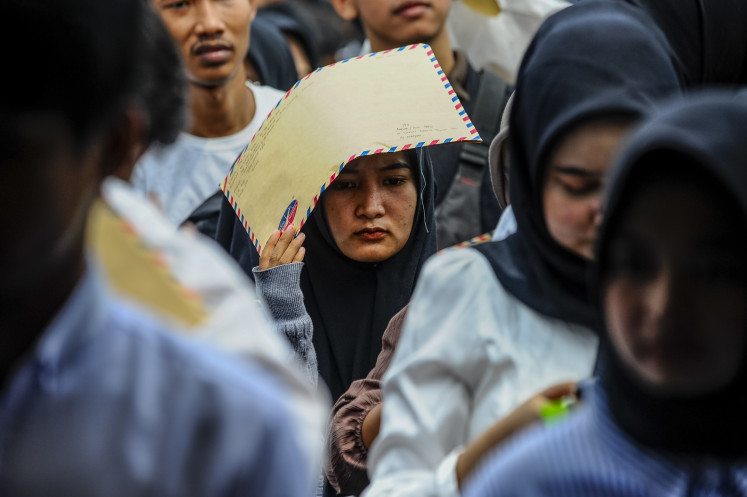Lack of disaster mitigation facilities still haunts Aceh
Floating reminder: Visitors enjoying the view around a former floating diesel power plant barge, PLTD Apung 1, in the Punge Blang Cut area in Banda Aceh, on Monday
Change text size
Gift Premium Articles
to Anyone
 Floating reminder: Visitors enjoying the view around a former floating diesel power plant barge, PLTD Apung 1, in the Punge Blang Cut area in Banda Aceh, on Monday. The barge was washed some 6 kilometers inland by the 2004 tsunami. (JP/Hotli Simanjuntak) (JP/Hotli Simanjuntak)
Floating reminder: Visitors enjoying the view around a former floating diesel power plant barge, PLTD Apung 1, in the Punge Blang Cut area in Banda Aceh, on Monday. The barge was washed some 6 kilometers inland by the 2004 tsunami. (JP/Hotli Simanjuntak) (JP/Hotli Simanjuntak)
F
span class="caption" style="width: 498px;">Floating reminder: Visitors enjoying the view around a former floating diesel power plant barge, PLTD Apung 1, in the Punge Blang Cut area in Banda Aceh, on Monday. The barge was washed some 6 kilometers inland by the 2004 tsunami. (JP/Hotli Simanjuntak)
It has been nine years since the devastating Indian Ocean tsunami struck Aceh in 2004, but as of today the province still has a shortage of proper disaster mitigation infrastructure, including communications systems, disaster relief shelters and escape roads, to combat potential natural disasters in the future.
'This time around, we are lacking disaster relief shelters in regions like Banda Aceh and Aceh Besar. Ideally, we should have 19 facilities, but currently we only have eight in the Ule Lheue area,' said Aceh Disaster Mitigation Agency (BPBA) head Jarwansyah.
BPBA, he said, was set to cooperate with the National Disaster Mitigation Agency (BNPB) to erect more escape evacuation buildings in tsunami-prone areas like the western coast of Aceh.
'We have a budget of Rp 10 billion (US$823,000) per year to build disaster relief shelters as well as to provide education programs for residents living in coastal areas. We will start both programs in 2014,' Jarwansyah said.
The Banda Aceh city administration is planning to build escape roads as well.
'We are still mapping out the ideal escape roads so the evacuation process would run smoothly without claiming many lives,' said Banda Aceh Deputy Mayor Illiza Saaduddin Djamal.
So far, the Banda Aceh administration has carried out tsunami drills to teach residents about safe evacuation processes in the event of a tsunami. The tsunami drill is also used to test the Tsunami Early Warning Systems (TEWS), which have been installed in a number of spots in Banda Aceh and the western coast of Aceh.
'We hope that the tsunami drills will raise people's awareness and knowledge on disaster mitigation so they can make the right decision in the event of such a disaster,' Illiza said.
Both the administration and the BPBA still have a difficult task as they are struggling to provide disaster-mitigation education to residents living in disaster-prone areas.
Illiza said that the Banda Aceh administration had urged residents to have their own disaster risk maps and standard operation procedures, which could be used when natural disasters occured.
A family, for instance, should decide on a specific meeting point in case all family members are in separate locations when a natural disaster hits their area in the future.
Residents have also been told to survey their areas so they know the best places to find refuge.
The BPBA has cooperated with five administrations across Aceh to procure education on disaster mitigation.
'Actually, 19 of 23 regencies/cities in Aceh are prone to natural disasters, but this time we will focus more on five regions, namely Banda Aceh, Aceh Besar, Aceh Jaya, Aceh Barat Daya and Simeulue Island,' Jarwansyah went on.
On Dec. 26, 2004, the Indian Ocean tsunami, which struck Indonesia and other countries, was triggered by a 9.0-magnitude undersea earthquake, leaving more than 126,000 people dead in Aceh, 37,000 missing and 500,000 others displaced.
Indonesia was the hardest-hit country in the disaster, followed by Sri Lanka, India and Thailand.
Up to now, local and foreign visitors still keep coming to Banda Aceh's tsunami-hit areas to have a look at the sites. Things have really changed as the damaged roads have been paved and many anti-quake houses have been built in the locations.
The only remnant of the 2004 tsunami is the PLTD Apung 1 barge, which was swept 6 kilometers inland.









